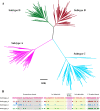Differential Vpu-Mediated CD4 and Tetherin Downregulation Functions among Major HIV-1 Group M Subtypes
- PMID: 32376625
- PMCID: PMC7343213
- DOI: 10.1128/JVI.00293-20
Differential Vpu-Mediated CD4 and Tetherin Downregulation Functions among Major HIV-1 Group M Subtypes
Abstract
Downregulation of BST-2/tetherin and CD4 by HIV-1 viral protein U (Vpu) promotes viral egress and allows infected cells to evade host immunity. Little is known however about the natural variability in these Vpu functions among the genetically diverse viral subtypes that contribute to the HIV-1 pandemic. We collected Vpu isolates from 332 treatment-naive individuals living with chronic HIV-1 infection in Uganda, Rwanda, South Africa, and Canada. Together, these Vpu isolates represent four major HIV-1 group M subtypes (A [n = 63], B [n = 84], C [n = 94], and D [n = 59]) plus intersubtype recombinants and uncommon strains (n = 32). The ability of each Vpu clone to downregulate endogenous CD4 and tetherin was quantified using flow cytometry following transfection into an immortalized T-cell line and compared to that of a reference Vpu clone derived from HIV-1 subtype B NL4.3. Overall, the median CD4 downregulation function of natural Vpu isolates was similar to that of NL4.3 (1.01 [interquartile range {IQR}, 0.86 to 1.18]), while the median tetherin downregulation function was moderately lower than that of NL4.3 (0.90 [0.79 to 0.97]). Both Vpu functions varied significantly among HIV-1 subtypes (Kruskal-Wallis P < 0.0001). Specifically, subtype C clones exhibited the lowest CD4 and tetherin downregulation activities, while subtype D and B clones were most functional for both activities. We also identified Vpu polymorphisms associated with CD4 or tetherin downregulation function and validated six of these using site-directed mutagenesis. Our results highlight the marked extent to which Vpu function varies among global HIV-1 strains, raising the possibility that natural variation in this accessory protein may contribute to viral pathogenesis and/or spread.IMPORTANCE The HIV-1 accessory protein Vpu enhances viral spread by downregulating CD4 and BST-2/tetherin on the surface of infected cells. Natural variability in these Vpu functions may contribute to HIV-1 pathogenesis, but this has not been investigated among the diverse viral subtypes that contribute to the HIV-1 pandemic. In this study, we found that Vpu function differs significantly among HIV-1 subtypes A, B, C, and D. On average, subtype C clones displayed the lowest ability to downregulate both CD4 and tetherin, while subtype B and D clones were more functional. We also identified Vpu polymorphisms that associate with functional differences among HIV-1 isolates and subtypes. Our study suggests that genetic diversity in Vpu may play an important role in the differential pathogenesis and/or spread of HIV-1.
Keywords: CD4; Downregulation; HIV-1; Vpu; subtype; tetherin.
Copyright © 2020 Umviligihozo et al.
Figures







References
-
- Strebel K, Klimkait T, Martin MA. 1988. A novel gene of HIV-1, Vpu, and its 16-kilodalton product. Am Assoc Adv Sci 241:1221–1223. - PubMed
-
- Sauter D, Schindler M, Specht A, Landford WN, Münch J, Kim KA, Votteler J, Schubert U, Bibollet-Ruche F, Keele BF, Takehisa J, Ogando Y, Ochsenbauer C, Kappes JC, Ayouba A, Peeters M, Learn GH, Shaw G, Sharp PM, Bieniasz P, Hahn BH, Hatziioannou T, Kirchhoff F. 2009. Tetherin-driven adaptation of Vpu and Nef function and the evolution of pandemic and nonpandemic HIV-1 strains. Cell Host Microbe 6:409–421. doi: 10.1016/j.chom.2009.10.004. - DOI - PMC - PubMed
Publication types
MeSH terms
Substances
Grants and funding
LinkOut - more resources
Full Text Sources
Medical
Molecular Biology Databases
Research Materials

